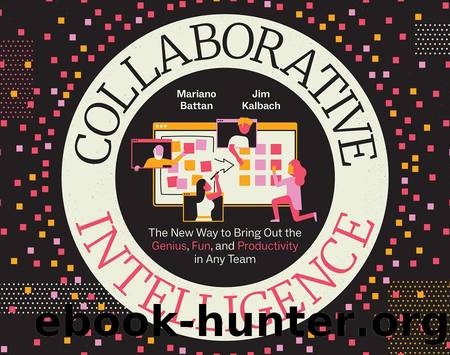Collaborative Intelligence by Mariano Battan & Jim Kalbach

Author:Mariano Battan & Jim Kalbach [Battan, Mariano & Kalbach, Jim]
Language: eng
Format: epub
ISBN: 9781119896548
Publisher: Wiley
Published: 2023-04-05T00:00:00+00:00
The Spaces We Make for Collaboration
In the past, a single, monolithic collaboration tool loomed over the teamwork landscape: the office building. Some leaders relied upon the fact that their teams shared a physical space almost to the exclusion of other means of collaboration.
Except any knowledge worker will tell you that putting people in proximity to each other doesn't guarantee collaboration. And as new spaces have given rise to new collaboration opportunities, innovative organizations must embrace these changes to the modalities of work..
Authentic collaboration spaces, whether physical, digital, or both, offer teams a place designed to support teamwork. That means supporting not only interaction and productivity toward a shared, common purpose but also supporting relationships. Our conception of a common space is one that's shared, radically accessible, inclusive of the entire team, and adaptable. It's also agnostic to locale, and its modality is flexible and adaptive to the needs of the people who use it.
There are several fundamental types of collaboration spaces we've identified:
Physical Spaces. For many reasons, physical collaboration space is (to date, at least) generally seen as unparalleled in its ability to create spontaneous connection. Relationships can be nurtured before meetings, during breaks, and at the end of the day. Body language and tone of voice add a richness to communication that people crave. Fact is, interacting in physical spaces feels comfortable and normal for us as humans. But more and more, we're seeing physical spaces powered with digital technology. Touchscreens, monitors, and kiosks allow teams to collaborate online even if they are interacting together in a physical space. The benefit is a better ability to transition to other types of spaces and other modes of collaboration.
Online Spaces. Because teams are less often in the same building, digital collaboration online has become the new norm. Here, our interaction with others is mediated completely through software. In this sense, the space that is created really amounts to a collection of tools.
Hybrid Spaces. Common spaces are not an eitherâor proposition. They are commonly combined in hybrid spaces, where some interact online while others are concurrently together in a physical space. While hybrid collaboration has become the dominant mode of working together postâpandemic, it's not new. In fact, around 60% of the teams we've polled worked in mixed spaces most of the time.
We've run several experiments in collaboration directly comparing different spaces and the effect they have on how teams work together. You can try it yourself: Have groups simultaneously participate in the same meeting or workshop from different settings, that is, one team inâperson, one remote only, and another hybrid. Give them the same challenge and observe how the team interacts and what they produce.
In many cases, we've found a common pattern emerges: The type and amount of content contributed during a given session varies across groups. Teams together in a physical space tend to take more time discussing the topic at hand and therefore generally produce a lower volume of content (e.g., ideas during brainstorming) than onlineâonly participants, who have fewer conversations but outpace the volume of content generated greatly.
Download
This site does not store any files on its server. We only index and link to content provided by other sites. Please contact the content providers to delete copyright contents if any and email us, we'll remove relevant links or contents immediately.
| Ethics | Etiquette |
| Fashion & Image | Health & Stress |
| Motivation & Self-Improvement | Work Life Balance |
| Workplace Culture |
Tools of Titans by Timothy Ferriss(8222)
Change Your Questions, Change Your Life by Marilee Adams(7637)
Deep Work by Cal Newport(6885)
Playing to Win_ How Strategy Really Works by A.G. Lafley & Roger L. Martin(5931)
Man-made Catastrophes and Risk Information Concealment by Dmitry Chernov & Didier Sornette(5924)
Digital Minimalism by Cal Newport;(5667)
Big Magic: Creative Living Beyond Fear by Elizabeth Gilbert(5615)
The Slight Edge by Jeff Olson(5352)
Ego Is the Enemy by Ryan Holiday(5297)
The Motivation Myth by Jeff Haden(5157)
Stone's Rules by Roger Stone(5027)
The Laws of Human Nature by Robert Greene(5001)
Tuesdays with Morrie by Mitch Albom(4695)
Eat That Frog! by Brian Tracy(4436)
Rising Strong by Brene Brown(4380)
Skin in the Game by Nassim Nicholas Taleb(4165)
Bullshit Jobs by David Graeber(4100)
The Money Culture by Michael Lewis(4082)
Skin in the Game: Hidden Asymmetries in Daily Life by Nassim Nicholas Taleb(3935)
